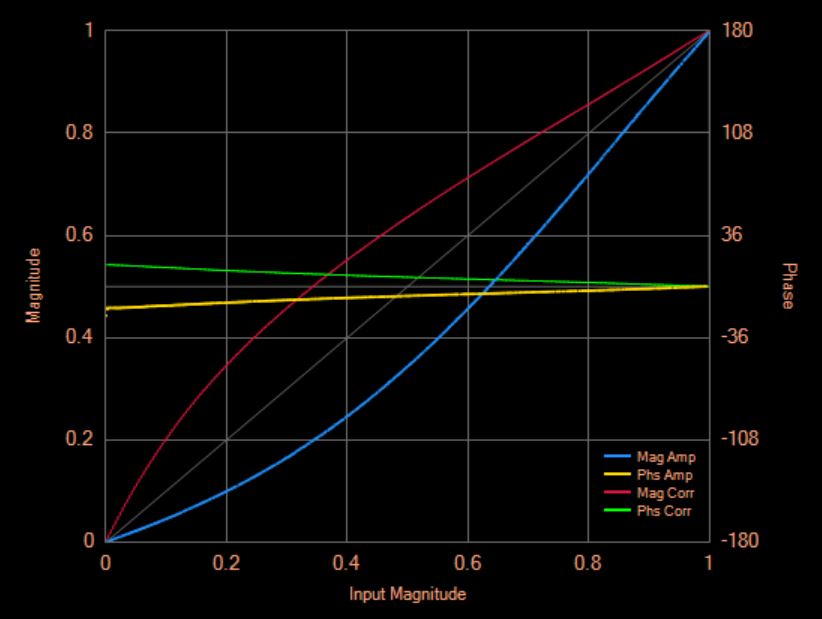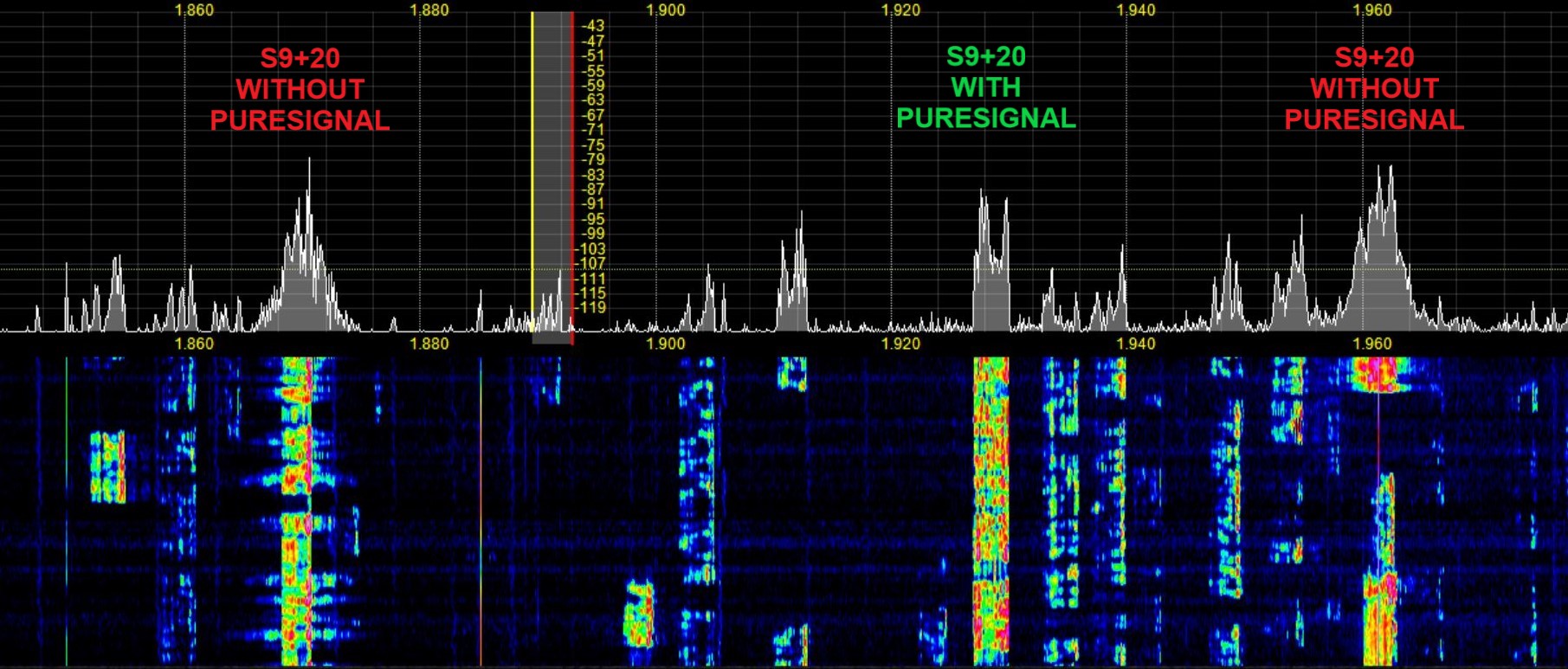Introduction
"PureSignal" is the name of a specific implementation of adaptive predistortion linearization developed for amateur radio by Warren Pratt, NR0V. PureSignal can be found ONLY in the two SDR applications most closely associated with Apache Labs radio hardware, PowerSDR mRX PS and Thetis. While adaptive pre-distortion linearization is common in industry, in particular the cellular phone world, as this was written (January 2019) PureSignal appears to be the only implementation of adaptive predistorion linearization in amateur radio and therefore exclusively limited to software defined radio (SDR) hardware that utilizes PowerSDR mRX PS and/or Thetis client software.What is Linearity?
Any amplifier channel wants to amplify the input signal with perfect linearity. That is to say, at any input power level there should be exactly the same amount of gain, and there should be exactly the same amount of phase shift as well. For example, put in 1W and get out 10W (10dB of gain), put in 10W and get out 100W (again 10dB of gain). Of course it is difficult to build a perfectly linear amplifier. And, worse, amateur radio operators rarely run their transmitters in a fashion that allows their amplifiers to run in their most linear fashion. This tends to result in intermodulation distortion (IMD) products occurring outside the desired transmit passband. The amateur radio term of art for this is "splatter". And don't we all hate splatter? Of course we do!What is Adaptive Predistortion Linearization?
If we can measure the non-linearity of the amplifier channel in both gain and phase, it should be possible to pre-distort the incoming signal in a way that causes the pre-distortion and non-linearity to cancel out. And in fact it is possible. This technique is used in many common RF systems, for example cellular base station transmitters.
As you can see in the figure here, taken from the PureSignal "AmpView" display, the blue and yellow lines are the actual gain and phase response of the amplifier channel. Any deviation from a diagonal line represents non-linear gain, any deviation from the horizontal line represents non-linear phase. Pre-distortion correction factors, represented by the green and yellow lines, are applied to the RF signal in the digital domain (where things can be perfectly linear) and appear on that signal as it exits the digital-to-analog converter (DAC) before it enters the non-linear, analog amplifier channel.
None of this would be possible without the use of some sort of RF coupler on the output of the amplifier channel and full duplex radio operation. The coupled output, at a much reduced power level, typically -40 to -50dB from the amplifier output depending on amplifier output power level, is presented during the transmission to the receiver input in full duplex fashion (simultaneous transmit and receive) by means of an RF switch to route the feedback signal appropriately to the receiver. The SDR digitizes this feedback signal, like any other RF signal, and compares it to the input signal to the amplifier to measure the non-linearity in near real-time. The output of these measurements are then used by the PureSignal algorithm to apply the appropriate correction factors to pre-distort the input signal that is output from the SDR DAC.
It should be mentioned that the above discussion is a highly simplified description of what goes on. There are many subtle and complex issues that must be and are addressed by the PureSignal algorithm that go well beyond this web page.
Benefits
Those of you who own radios with waterfall displays will immediately recognize the primary benefit, which is the almost total eradication of any significant intermodulation distortion (IMD) products outside of the desired transmit passband. One can almost always identify a signal from an Apache Labs radio operating with PureSignal as these signals produce spectra on a waterfall display that looks almost as if someone took a razor blade to each side.As you can see from the figures at the top of the page, achieving greater than -50dBc IMD products even with very poor, non-linearized input conditions is quite typical of the performance of the PureSignal algorithm. Given that an S9+20 signal is rarely much more than 50dB over a typical panadapter noise floor, this is more than sufficient to create a best case condition for adjacent stations. It is not unusual to observe more than one PureSignal equipped QSO occurring with literally no spacing between passbands, and when combined with the brick-wall filters in the PowerSDR and Thetis software, these two adjacent QSOs can proceed without any QRM present in either channel.
Another benefit of highly effective linearization is that voice reproduction is extremely accurate for both SSB and AM phone operations. These improvements are significant and easily audible. Just ask any Apache Labs radio user to turn PureSignal on and off during a QSO and hear for yourself. Combined with a highly capable voice processing channel in the in the SDR client software, there is no better sounding audio on the air.
The final benefit is the ability to be "loud" without splattering the hell out of the band. Loudness is, of course, merely the absence of dynamic range in an audio signal. Minimizing the dynamic range of your audio will minimize the peak-to-average-power ratio (PAPR, or "crest factor") of the transmitter RF output. The time-honored amateur radio tradition of over-driving a "linear" amplifier into compression to accomplish this is exactly the wrong way to do it! And PureSignal will fight you tooth and nail to linearize your highly compressed condition. PureSignal will win, too! Instead, both SDR client software applications that implement PureSignal, PowerSDR mRX PS and Thetis, both contain no less than three stages of multi-band audio compression. This allows you to compress the dynamic range of the audio and then transmit that compressed audio perfectly linearly. The result is loudness and low PAPR without IMD! For further reading on this last topic, see the article here: https://apache-labs.com/community/viewtopic.php?f=20&t=2862
The Future of Amateur Radio

It only takes one good look at a panadapter or waterfall display to see that linearization of one form or another is the future of amateur radio. In the figure above there are three S9+20 signals. The two conventional, non-linearized signals are utilizing 8KHz or so, nearly three times the desired bandwidth. The signal linearized with PureSignal is occupying exactly the passband required and desired, no more, no less. And it sounds better, too. Which one of the three signals would you like to be? Perhaps more importantly, which one of the three signals would you like to be on an adjacent frequency to your QSO?
This is the future of amateur radio. The amplifier manufacturers are climbing on board the linearization train fast. Elecraft, Linear Amps UK, Palstar, rf-kit.de, Flex; all are now shipping or are planning to ship amplifiers with the necessary RF feedback output built-in. For those who don't have this, inexpensive high power RF couplers are just a mouse click away. Now all that remains is for the radio manufacturers, other than Apache, to get on board, too.
# # #